
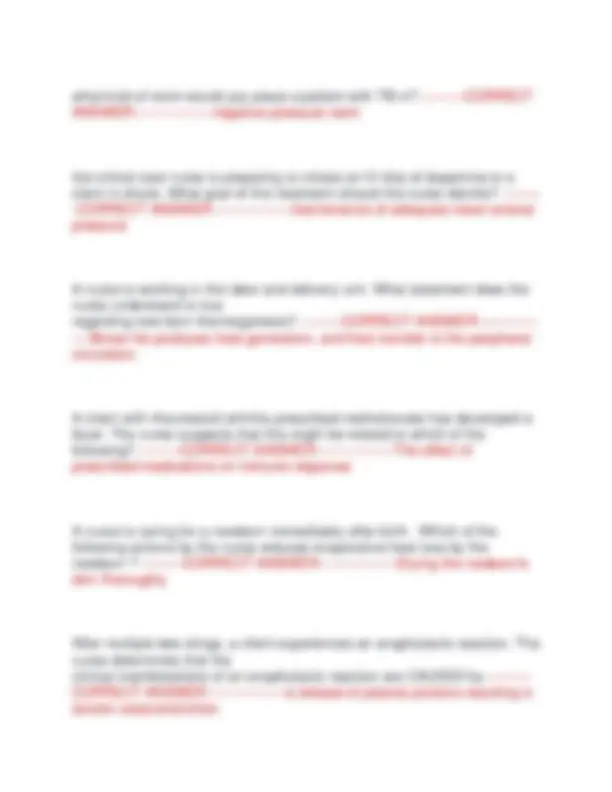
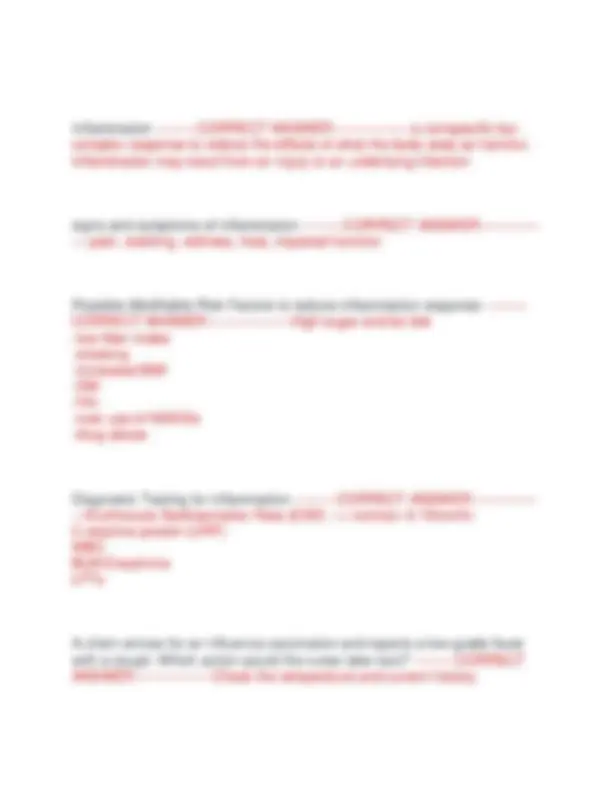
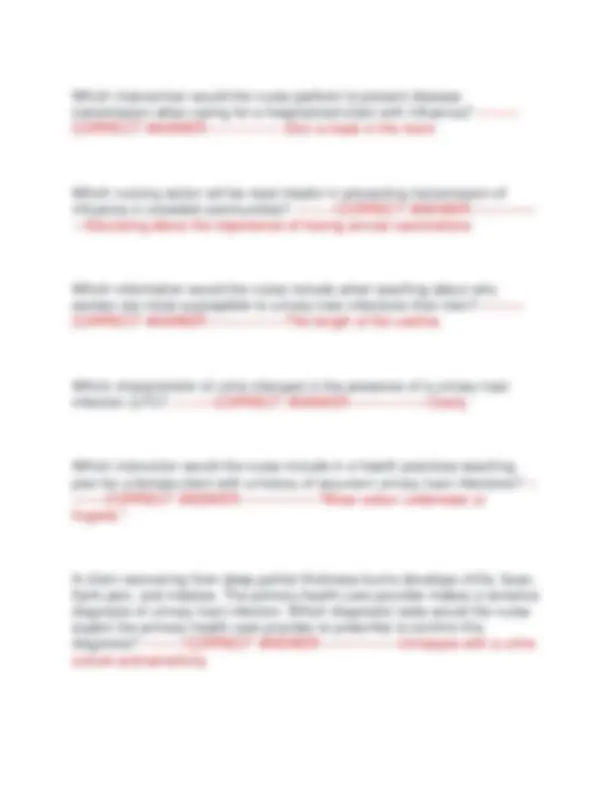
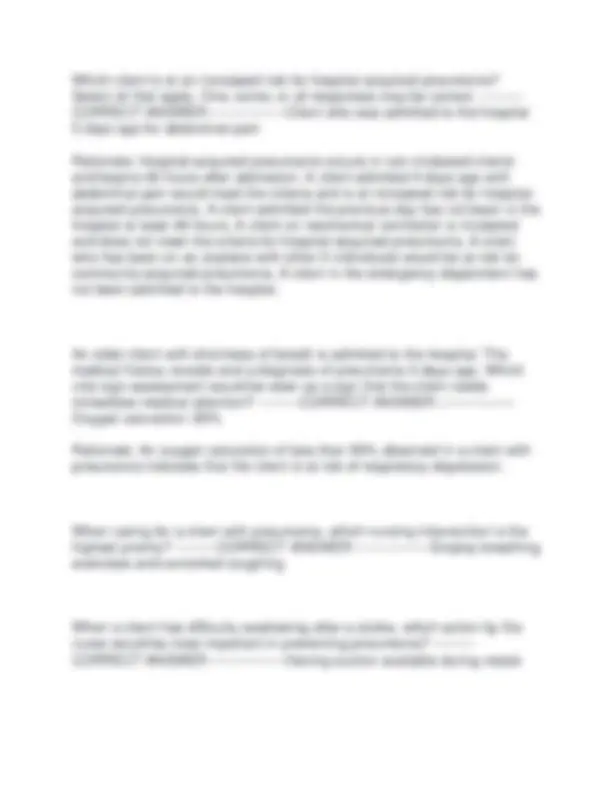
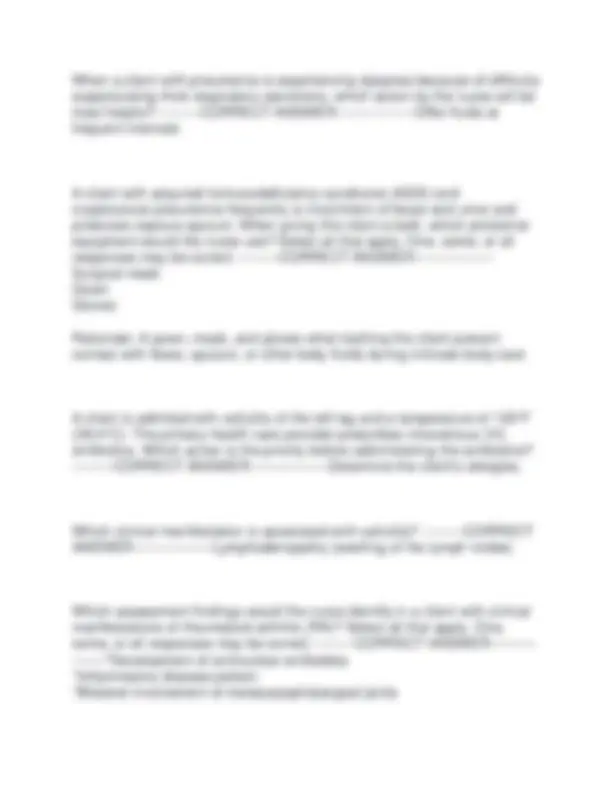
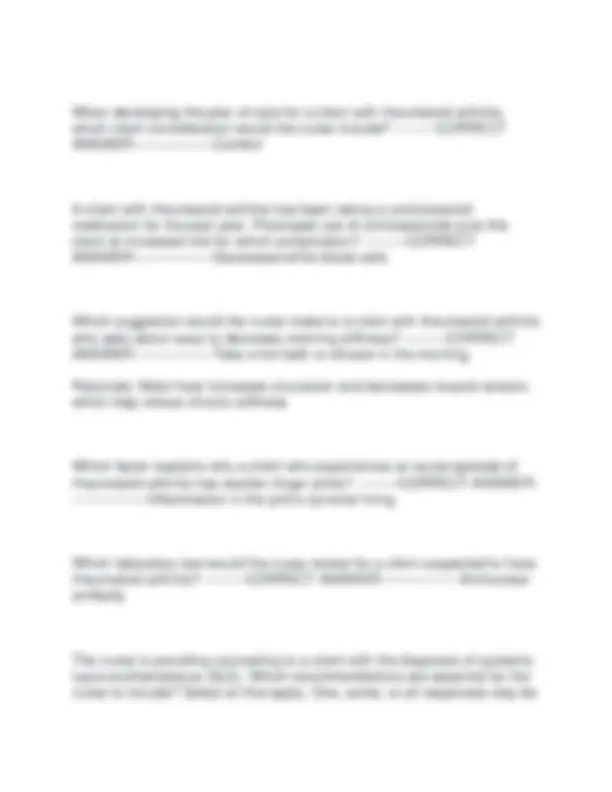
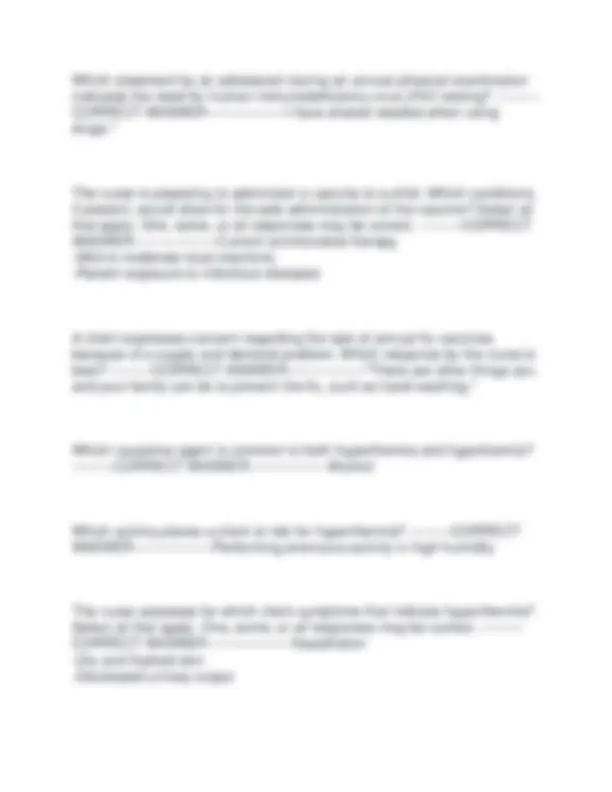
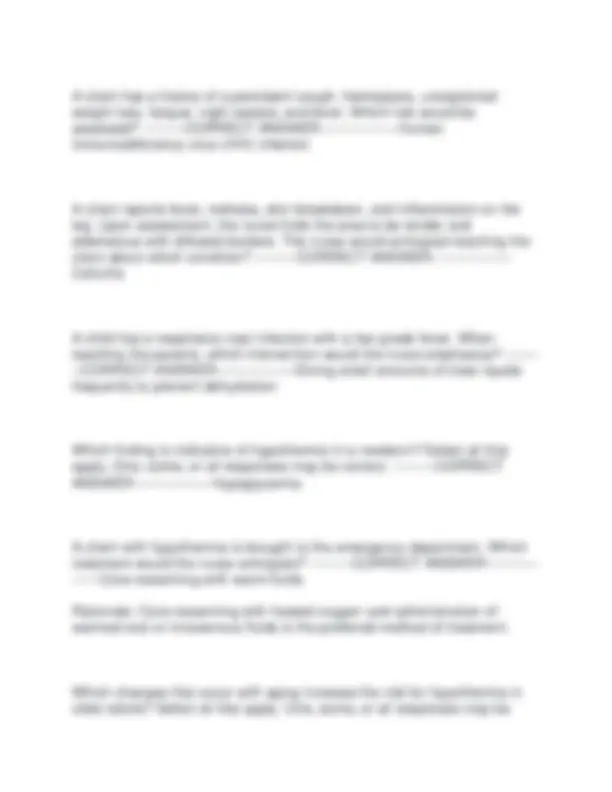
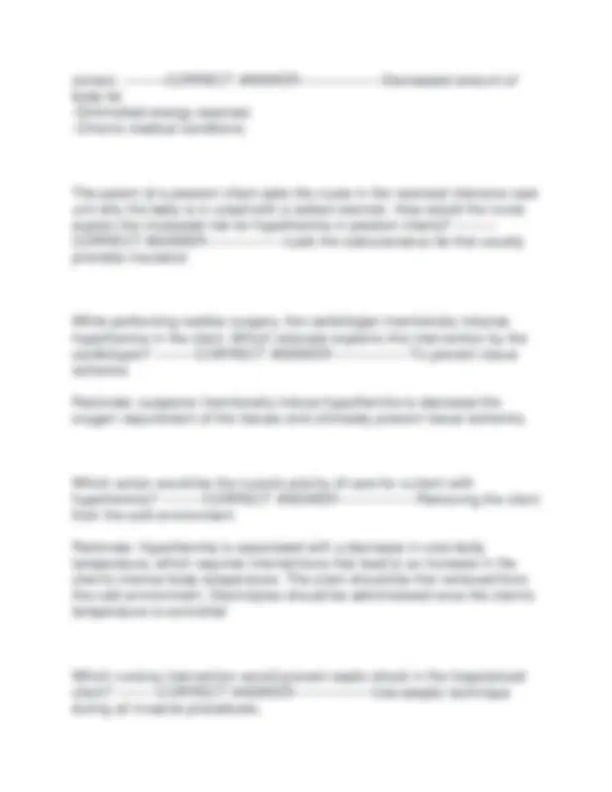
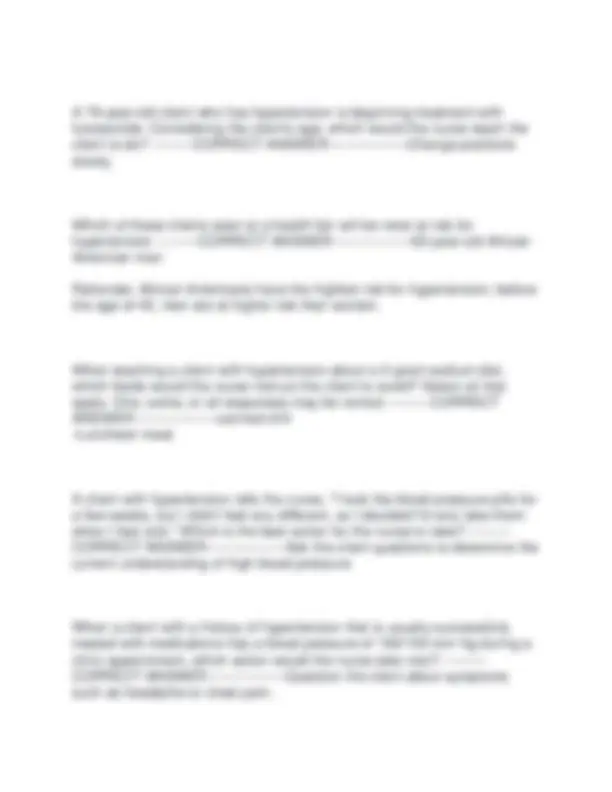
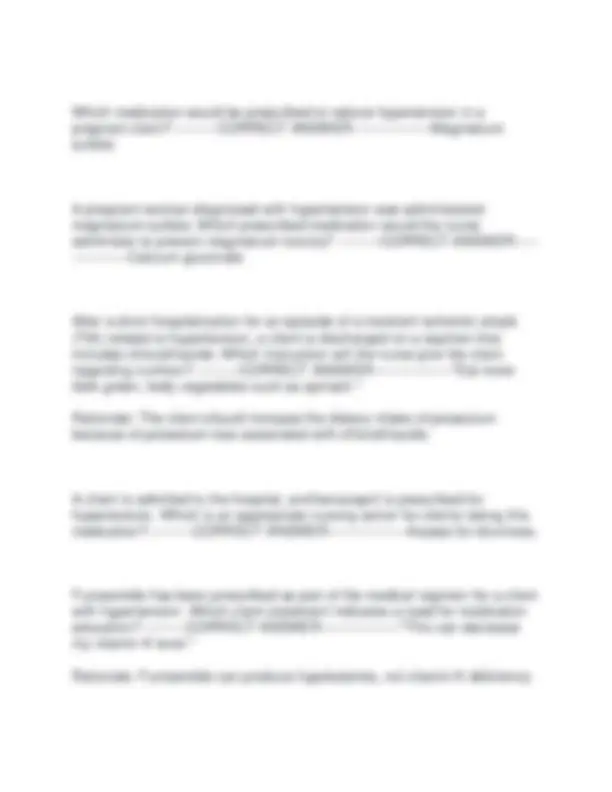
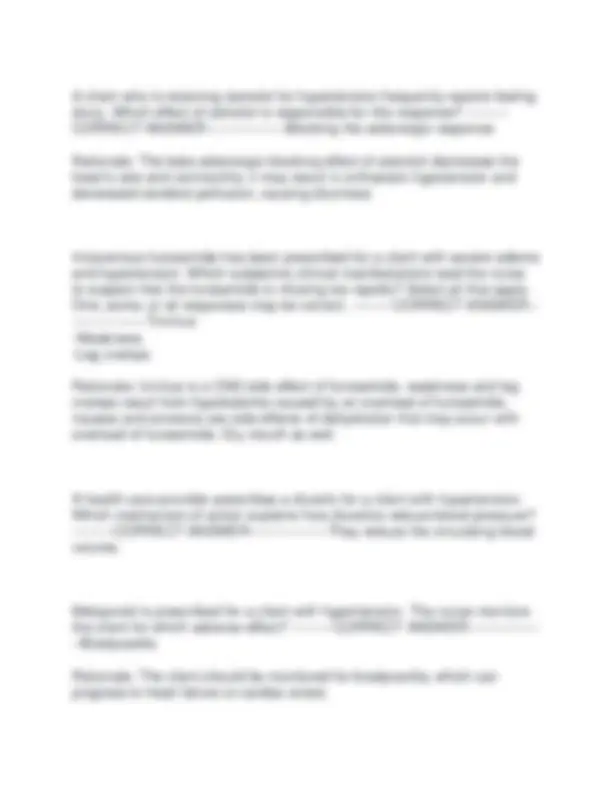
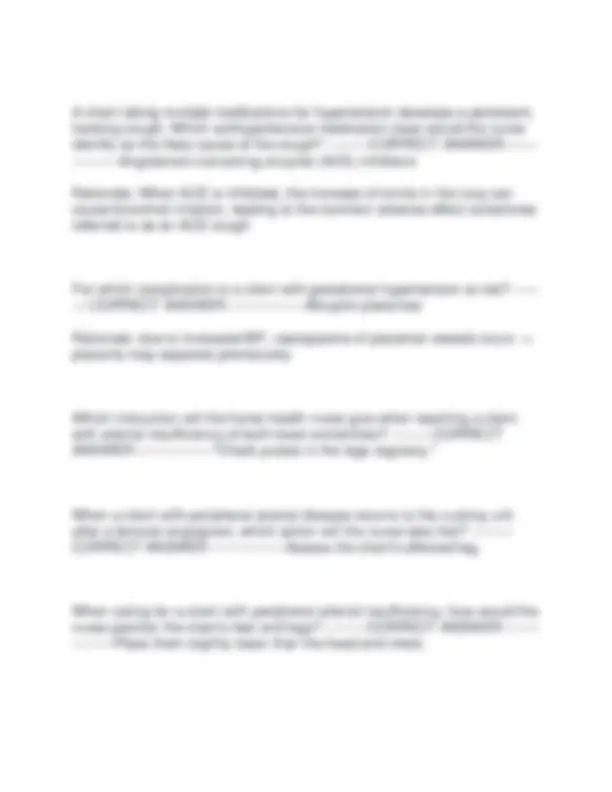
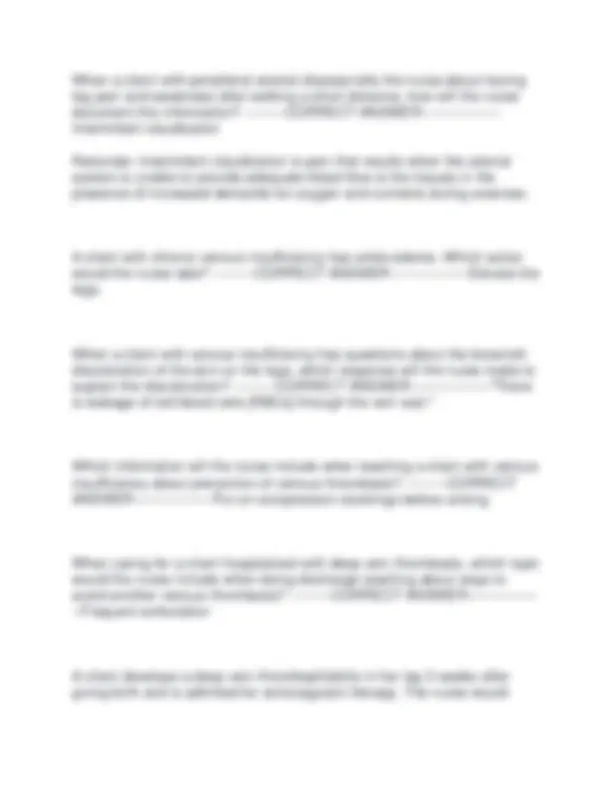
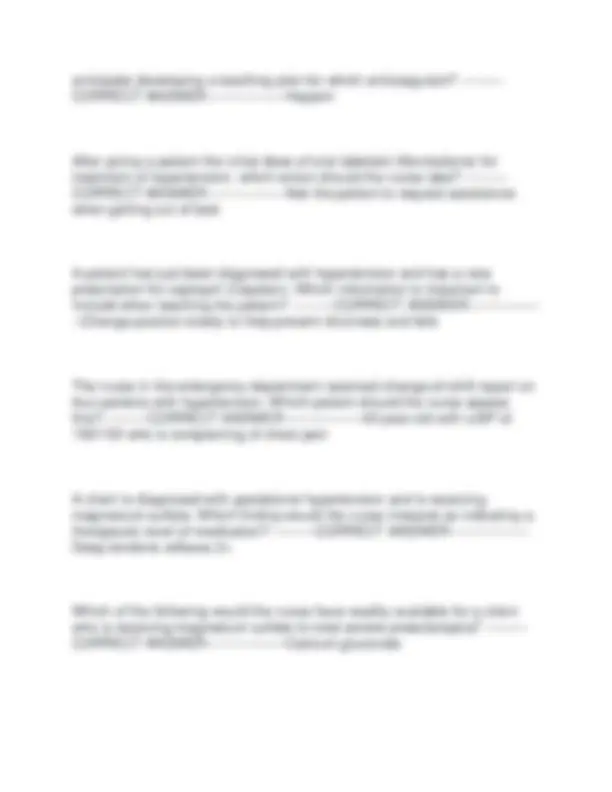
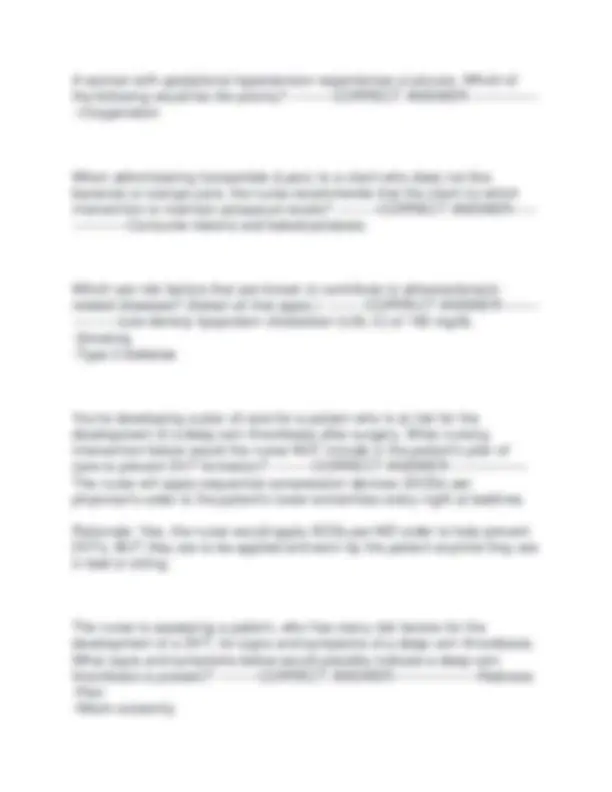
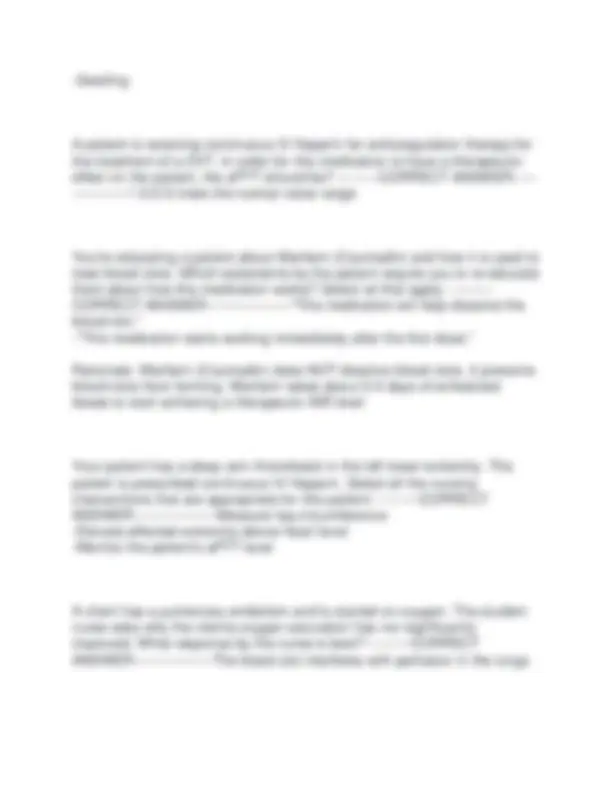
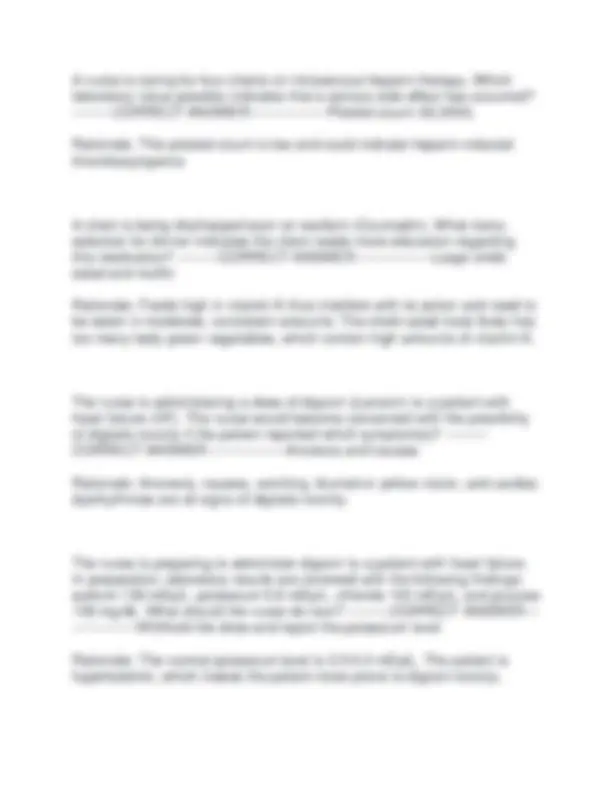
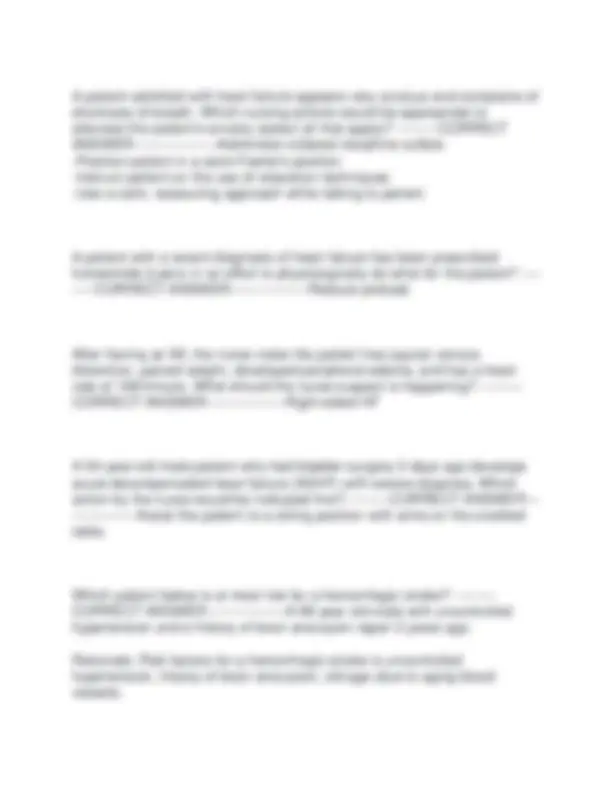
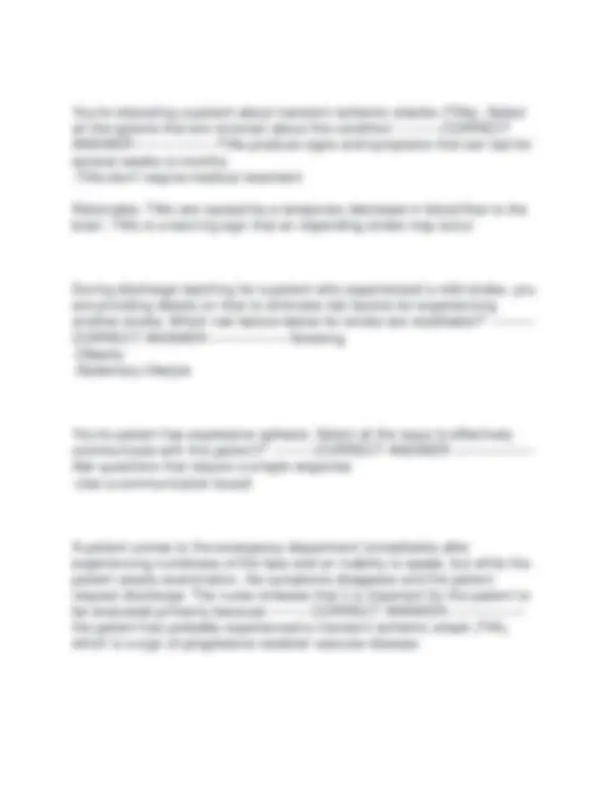
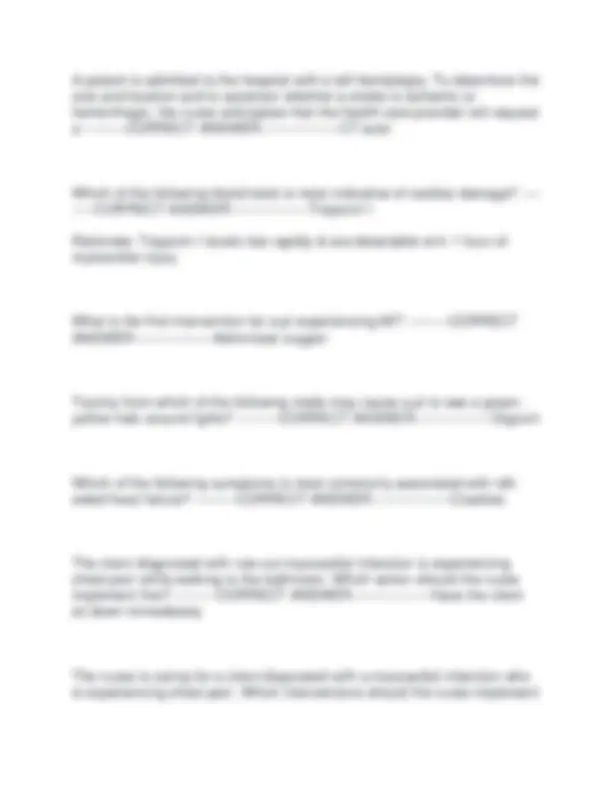
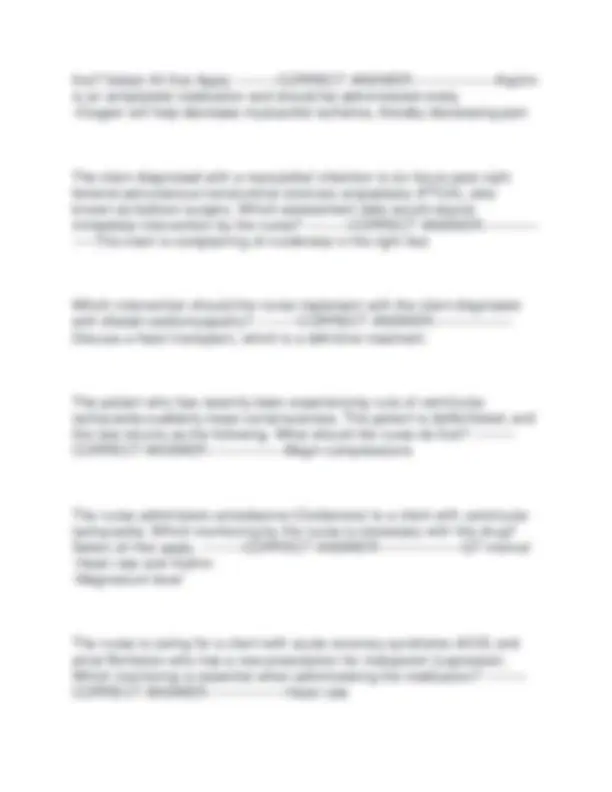
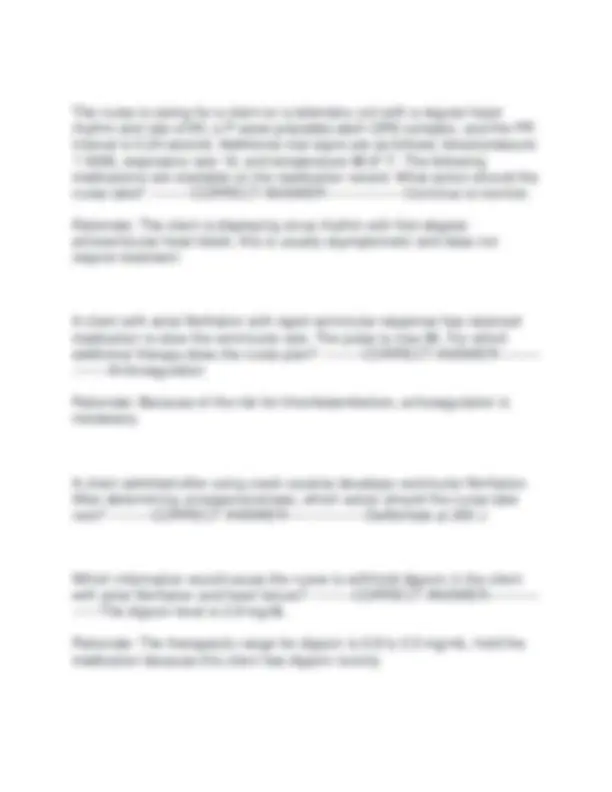
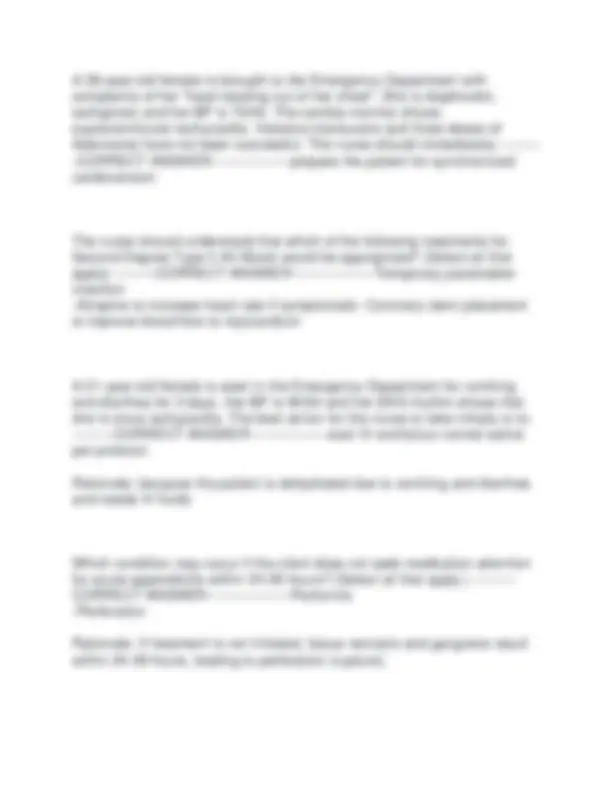
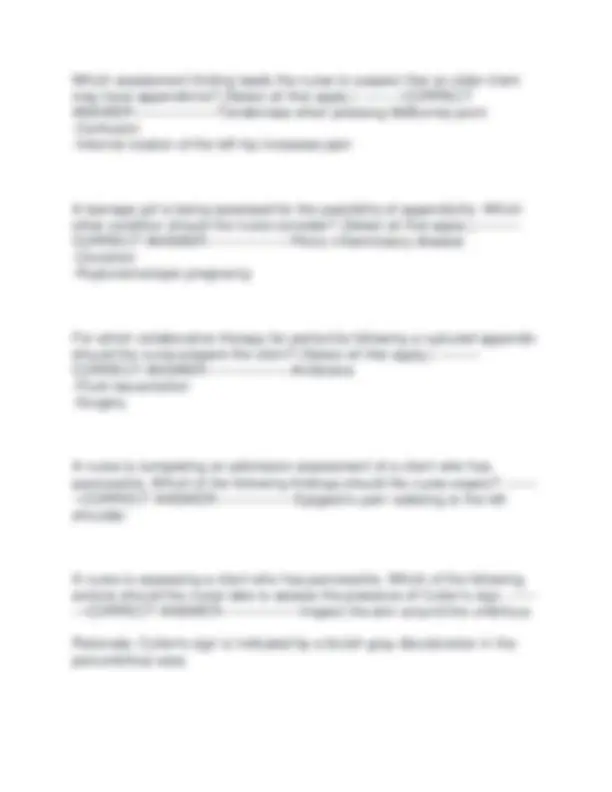
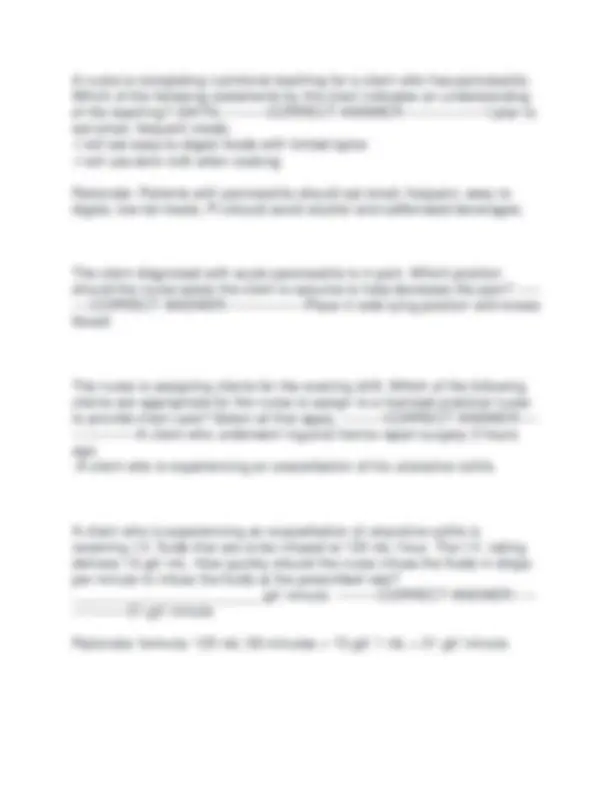
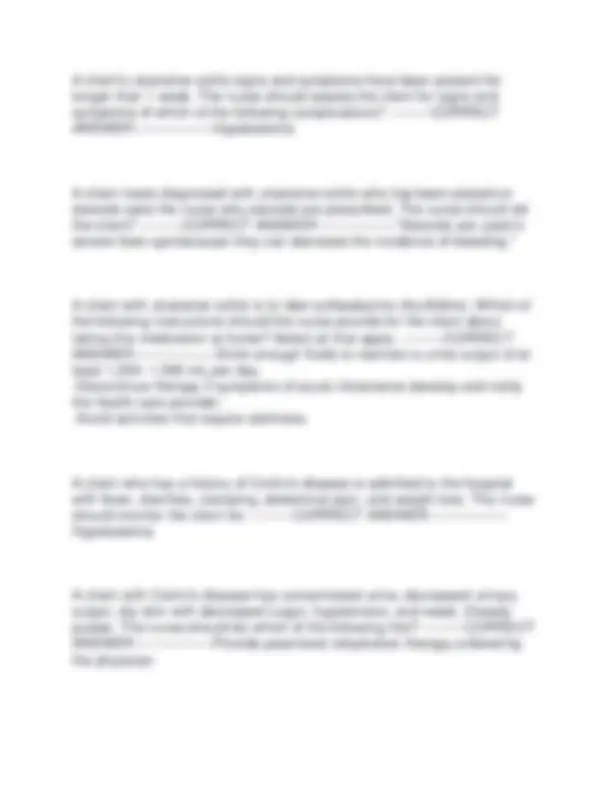
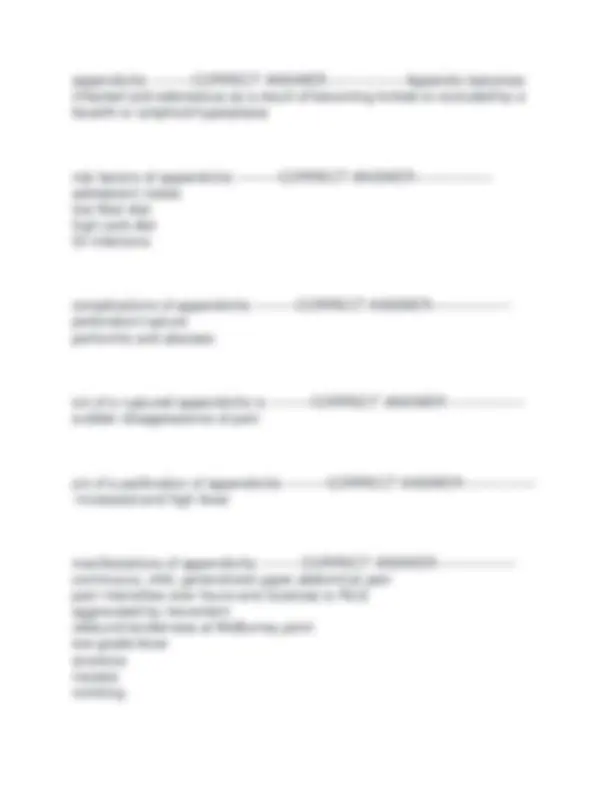
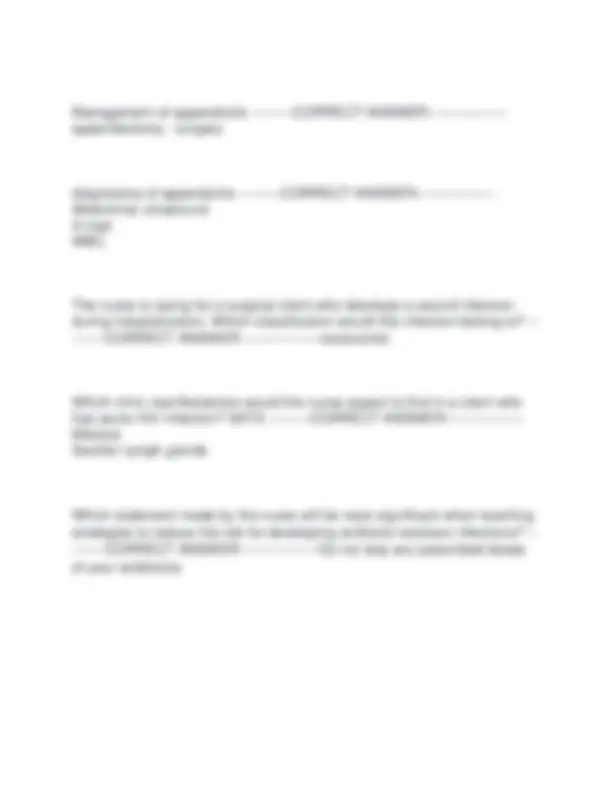


Study with the several resources on Docsity

Earn points by helping other students or get them with a premium plan


Prepare for your exams
Study with the several resources on Docsity

Earn points to download
Earn points by helping other students or get them with a premium plan
Community
Ask the community for help and clear up your study doubts
Discover the best universities in your country according to Docsity users
Free resources
Download our free guides on studying techniques, anxiety management strategies, and thesis advice from Docsity tutors
A comprehensive review of key concepts and answers for nu 372 final exam 2025. It covers various topics related to nursing, including crohn's disease, peptic ulcer disease, tuberculosis, inflammation, and infectious diseases. Multiple-choice questions with correct answers, providing a valuable resource for students preparing for the exam.
Typology: Exams
1 / 37

This page cannot be seen from the preview
Don't miss anything!






























The nurse is developing a plan of care for a client with Crohn's disease who is receiving total parenteral nutrition (TPN). Which of the following interventions should the nurse include? Select all that apply --------- CORRECT ANSWER------------------Weighing the client daily.
Which physical examination should the nurse implement first when assessing the client diagnosed with peptic ulcer disease? --------- CORRECT ANSWER-----------------Auscultate the clients bowel sounds in all four quadrants The nurse has been assigned to care for a client diagnosed with peptic ulcer disease. Which assessment data require further intervention? --------- CORRECT ANSWER-----------------A decrease in systolic BP of 20 mm Hg from lying to sitting Rationale: this indicates orthostatic hypotension - > can indicate bleeding The nurse has administered an antibiotic, a proton pump inhibitor, and Pepto- Bismol for peptic ulcer disease secondary to H. pylori. Which data would indicate to the nurse the medications are effective? --------- CORRECT ANSWER-----------------A decrease in gastric distress The client with a history of peptic ulcer disease is admitted into the intensive care unit with frank gastric bleeding. Which priority intervention should the nurse implement? ---------CORRECT ANSWER----------------- Insert a nasogastric tube and begin saline lavage Rationale: this directly stops the bleeding The client with peptic ulcer disease (PUD) asks the nurse whether licorice and slippery elm might be useful in managing the disease. What is the nurse's best response? ---------CORRECT ANSWER-----------------"These herbs could be helpful. However, you should talk with your physician before adding them to your treatment regimen."
Inflammation ---------CORRECT ANSWER-----------------a nonspecific but complex response to reduce the effects of what the body sees as harmful. Inflammation may result from an injury or an underlying infection signs and symptoms of inflammation ---------CORRECT ANSWER------------- ----pain, swelling, redness, heat, impaired function Possible Modifiable Risk Factors to reduce inflammation response --------- CORRECT ANSWER------------------High sugar and fat diet
Which intervention would the nurse perform to prevent disease transmission when caring for a hospitalized client with influenza? --------- CORRECT ANSWER-----------------Don a mask in the room Which nursing action will be most helpful in preventing transmission of influenza in crowded communities? ---------CORRECT ANSWER-------------- ---Educating about the importance of having annual vaccinations Which information would the nurse include when teaching about why women are more susceptible to urinary tract infections than men? --------- CORRECT ANSWER-----------------The length of the urethra Which characteristic of urine changes in the presence of a urinary tract infection (UTI)? ---------CORRECT ANSWER-----------------Clarity Which instruction would the nurse include in a health practices teaching plan for a female client with a history of recurrent urinary tract infections? -- -------CORRECT ANSWER-----------------"Wear cotton underwear or lingerie." A client recovering from deep partial-thickness burns develops chills, fever, flank pain, and malaise. The primary health care provider makes a tentative diagnosis of urinary tract infection. Which diagnostic tests would the nurse expect the primary health care provider to prescribe to confirm this diagnosis? ---------CORRECT ANSWER-----------------Urinalysis with a urine culture and sensitivity
A client arrives at a health clinic stating, "I am here to have my tuberculin skin test read." The nurse notes that there is a 7-mm indurated area at the injection site. Which statement made by the nurse correctly describes this result? ---------CORRECT ANSWER-----------------"The result indicates that you are infected with the tuberculosis organism." A client with tuberculosis receives instructions regarding isoniazid (INH) therapy from the assigned nurse. Which client statement indicates a misunderstanding of the content? ---------CORRECT ANSWER----------------- "I should apply sunscreen and wear sun-protective clothing while going outside." Rationale: This medication is not a photosensitive medication. All the rest of the statements are accurate. The nurse identifies 12 mm of induration at the site of a client's tuberculin purified protein derivative (PPD) test. Which rational would the nurse use to explain this test? ---------CORRECT ANSWER-----------------The result indicates a need for further tests and a chest x-ray. Rationale: The test result is positive, not negative; thus further testing is necessary. It is the most accurate skin test for tuberculosis (TB) because of the testing material and the intradermal method used Which clinical manifestations are associated with a diagnosis of tuberculosis? Select all that apply. ---------CORRECT ANSWER----------------
Which client is at an increased risk for hospital-acquired pneumonia? Select all that apply. One, some, or all responses may be correct. --------- CORRECT ANSWER-----------------Client who was admitted to the hospital 5 days ago for abdominal pain Rationale: Hospital-acquired pneumonia occurs in non-intubated clients and begins 48 hours after admission. A client admitted 5 days ago with abdominal pain would meet the criteria and is at increased risk for hospital- acquired pneumonia. A client admitted the previous day has not been in the hospital at least 48 hours. A client on mechanical ventilation is intubated and does not meet the criteria for hospital-acquired pneumonia. A client who has been on an airplane with other ill individuals would be at risk for community-acquired pneumonia. A client in the emergency department has not been admitted to the hospital. An older client with shortness of breath is admitted to the hospital. The medical history reveals and a diagnosis of pneumonia 3 days ago. Which vital sign assessment would be seen as a sign that the client needs immediate medical attention? ---------CORRECT ANSWER----------------- Oxygen saturation: 89% Rationale: An oxygen saturation of less than 90% observed in a client with pneumonia indicates that the client is at risk of respiratory depression. When caring for a client with pneumonia, which nursing intervention is the highest priority? ---------CORRECT ANSWER-----------------Employ breathing exercises and controlled coughing When a client has difficulty swallowing after a stroke, which action by the nurse would be most important in preventing pneumonia? --------- CORRECT ANSWER-----------------Having suction available during meals
When developing the plan of care for a client with rheumatoid arthritis, which client consideration would the nurse include? ---------CORRECT ANSWER-----------------Comfort A client with rheumatoid arthritis has been taking a corticosteroid medication for the past year. Prolonged use of corticosteroids puts this client at increased risk for which complication? ---------CORRECT ANSWER-----------------Decreased white blood cells Which suggestion would the nurse make to a client with rheumatoid arthritis who asks about ways to decrease morning stiffness? ---------CORRECT ANSWER-----------------Take a hot bath or shower in the morning. Rationale: Moist heat increases circulation and decreases muscle tension, which help relieve chronic stiffness Which factor explains why a client who experiences an acute episode of rheumatoid arthritis has swollen finger joints? ---------CORRECT ANSWER- ----------------Inflammation in the joint's synovial lining Which laboratory test would the nurse review for a client suspected to have rheumatoid arthritis? ---------CORRECT ANSWER-----------------Antinuclear antibody The nurse is providing counseling to a client with the diagnosis of systemic lupus erythematosus (SLE). Which recommendations are essential for the nurse to include? Select all that apply. One, some, or all responses may be
correct. ---------CORRECT ANSWER------------------"Wear a large-brimmed hat."
Which statement by an adolescent during an annual physical examination indicates the need for human immunodeficiency virus (HIV) testing? --------- CORRECT ANSWER-----------------I have shared needles when using drugs." The nurse is preparing to administer a vaccine to a child. Which conditions, if present, would allow for the safe administration of the vaccine? Select all that apply. One, some, or all responses may be correct. ---------CORRECT ANSWER------------------Current antimicrobial therapy
A client has a history of a persistent cough, hemoptysis, unexplained weight loss, fatigue, night sweats, and fever. Which risk would be assessed? ---------CORRECT ANSWER-----------------Human immunodeficiency virus (HIV) infection A client reports fever, redness, skin breakdown, and inflammation on the leg. Upon assessment, the nurse finds the area to be tender and edematous with diffused borders. The nurse would anticipate teaching the client about which condition? ---------CORRECT ANSWER----------------- Cellulitis A child has a respiratory tract infection with a low-grade fever. When teaching the parents, which intervention would the nurse emphasize? ------- --CORRECT ANSWER-----------------Giving small amounts of clear liquids frequently to prevent dehydration Which finding is indicative of hypothermia in a newborn? Select all that apply. One, some, or all responses may be correct. ---------CORRECT ANSWER-----------------Hypoglycemia A client with hypothermia is brought to the emergency department. Which treatment would the nurse anticipate? ---------CORRECT ANSWER----------- ------Core rewarming with warm fluids Rationale: Core rewarming with heated oxygen and administration of warmed oral or intravenous fluids is the preferred method of treatment. Which changes that occur with aging increase the risk for hypothermia in older adults? Select all that apply. One, some, or all responses may be
The nurse is assessing a client who had a bowel resection 4 hours ago. Which finding would the nurse identify as an early sign of shock? --------- CORRECT ANSWER-----------------Restlessness Rationale: In the early stage of shock, the client has increased epinephrine secretion. This, in turn, causes the client to become restless, anxious, nervous, and irritable Which clinical manifestations would the nurse observe in a client experiencing a full-blown anaphylactic shock from a type I latex allergic reaction? Select all that apply. One, some, or all responses may be correct. ---------CORRECT ANSWER------------------Stridor
When a client with hypovolemic shock has a hematocrit value of 25%, which fluid therapy will the nurse prepare to infuse? ---------CORRECT ANSWER-----------------Packed red blood cells Rationale: Blood replacement is needed to increase the oxygen-carrying capacity of the blood; the expected hematocrit for women is 37% to 47% and for men is 42% to 52%. Which clinical manifestations would the nurse expect when assessing a client who is diagnosed with cardiogenic shock? Select all that apply. One, some, or all responses may be correct. ---------CORRECT ANSWER--------- ---------Tachycardia
Which medication would be prescribed to reduce hypertension in a pregnant client? ---------CORRECT ANSWER-----------------Magnesium sulfate A pregnant woman diagnosed with hypertension was administered magnesium sulfate. Which prescribed medication would the nurse administer to prevent magnesium toxicity? ---------CORRECT ANSWER----- ------------Calcium gluconate After a short hospitalization for an episode of a transient ischemic attack (TIA) related to hypertension, a client is discharged on a regimen that includes chlorothiazide. Which instruction will the nurse give the client regarding nutrition? ---------CORRECT ANSWER-----------------"Eat more dark green, leafy vegetables such as spinach." Rationale: The client should increase the dietary intake of potassium because of potassium loss associated with chlorothiazide. A client is admitted to the hospital, and benazepril is prescribed for hypertension. Which is an appropriate nursing action for clients taking this medication? ---------CORRECT ANSWER-----------------Assess for dizziness. Furosemide has been prescribed as part of the medical regimen for a client with hypertension. Which client statement indicates a need for medication education? ---------CORRECT ANSWER-----------------"This can decrease my vitamin K level." Rationale: Furosemide can produce hypokalemia, not vitamin K deficiency
A client who is receiving atenolol for hypertension frequently reports feeling dizzy. Which effect of atenolol is responsible for this response? --------- CORRECT ANSWER-----------------Blocking the adrenergic response Rationale: The beta-adrenergic blocking effect of atenolol decreases the heart's rate and contractility; it may result in orthostatic hypotension and decreased cerebral perfusion, causing dizziness Intravenous furosemide has been prescribed for a client with severe edema and hypertension. Which subjective clinical manifestations lead the nurse to suspect that the furosemide is infusing too rapidly? Select all that apply. One, some, or all responses may be correct. ---------CORRECT ANSWER-- ----------------Tinnitus